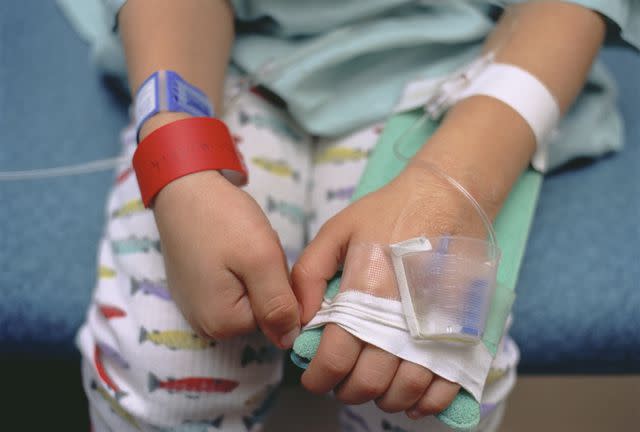Emergency Treatment for Sudden Epiglottitis

LWA / Getty Images
Medically reviewed by Benjamin F. Asher, MD
Epiglottitis is inflammation and swelling of the epiglottis—the tissue at the base of the tongue that covers the windpipe. It can be a life-threatening condition if left untreated. Your epiglottis is mainly made up of cartilage tissue. It behaves like a valve to prevent foods and liquids from entering your windpipe.
The cartilage tissue of the epiglottis can become swollen or infected. The swelling might become severe enough to block the airway. If this happens, you need emergency medical care to prevent airway blockage.
Epiglottitis is more common in children but can also affect adults. Causes of epiglottitis include infections and injuries or burns to the throat.
The article covers when to call 911 for epiglottitis, the anatomy and function of the epiglottis, epiglottitis common causes and symptoms, and more.

LWA / Getty Images
When to Call 911 for Epiglottitis
Epiglottitis can be a life-threatening condition that requires emergency treatment. You should seek immediate medical attention or call 911 if an adult or child is experiencing breathing troubles.
Breathing difficulties are a late sign of epiglottitis. This is because swelling of the epiglottis causes the airway to close or be completely blocked off. Either scenario could be fatal.
Related: What Happens After You Call 911?
Can You See Your Epiglottis?
The epiglottis is the leaf-shaped flap in the throat at the base of the tongue that keeps food and water from entering the trachea (windpipe) and the lungs. The epiglottis will stay open while you breathe, but when you swallow, it directs swallowed foods and liquids toward the esophagus (the muscular tube that delivers food from your mouth to your stomach).
Made of elastic cartilage and encased in a mucous membrane, the epiglottis is attached to the end of the larynx (voice box). It pushes up and backward behind your tongue and hyoid bone—the U-shaped bone at the front of the neck supporting the tongue and the larynx.
While rare to see, the epiglottis can be visible in people with a large epiglottis or a shallow (low-depth) throat. A visible epiglottis would be generally asymptomatic (no symptoms) and not require medical or surgical intervention. This is most often seen in children, but some reported incidences in adults have been reported.
A visible epiglottis is usually nothing to worry about if there are no breathing or swallowing problems.
Common Epiglottitis Causes
Bacterial, fungal, and viral infections are the most common cause of epiglottitis. The most common infectious causes are Haemophilus influenzae, Streptococcus pneumoniae and other strep species, and respiratory tract viruses. There have also been cases of epiglottitis linked to COVID-19.
It is also possible to experience epiglottitis following heat damage. Thermal epiglottitis can occur after ingesting hot liquids or eating very hot foods.
There are also incidences of thermal epiglottitis related to recreational drug use. This could occur from accidentally inhaling heated objects, such as broken crack pipes or tips of marijuana cigarettes. E-cigarettes can also cause epiglottitis, especially in adolescents.
Blunt trauma to the throat, a throat blockage, and an allergic reaction are additional causes. Allergic reactions can cause the epiglottis to become inflamed and swell up.
COVID-19 and Epiglottitis
COVID-19 is a viral respiratory illness associated with many complications within and outside the respiratory tract. According to a 2021 report, COVID-19 has been found to affect the larynx, including the epiglottis. Epiglottitis linked to severe COVID-19 can reduce the ability for intubation, leading to a need for an emergent surgical airway.
Risk Factors
Anyone can develop epiglottitis, but there are factors that increase your risk for the condition.
Such risk factors include:
Age: The condition commonly occurs in children ages 2 to 6. The risk is also higher in adults over 85. Children younger than 12 months who have not completed their Hib vaccine (the vaccine that prevents Haemophilus influenzae type B) series and children living in countries not offering Hib vaccines are also at an increased risk.
Sex: People assigned male at birth are more likely to develop epiglottitis, but the reasons for this are unclear.
Having a weakened immune system: A weakened immune system increases your risk for all types of infections, including those that cause epiglottitis. Diabetes and chronic obstructive pulmonary disease (COPD) are additional risk factors.
Being around large groups of people: Frequently being in a large group setting makes it more likely for you to acquire infections. This is commonly seen in school children and children in child care centers.
Recognizing Epiglottitis Symptoms
Epiglottitis can appear suddenly and worsen quickly. The condition's most common symptoms are sometimes referred to as the "four Ds."
The four Ds are:
Dysphagia (difficulty swallowing)
Dysphonia (voice hoarseness or difficulty speaking)
Drooling (saliva flowing from the mouth)
Distress (difficulty with breathing or getting oxygen)
Additional symptoms of the condition might include:
Sore throat
Pain with swallowing
Abnormal breathing sound (stridor)
Fever
Irritability or restlessness
An upper respiratory infection (often the start of symptoms)
Is Epiglottitis Contagious?
If epiglottitis results from a bacterial, viral, or fungal infection, the infection might be contagious. An infection that has led to epiglottitis may be transmitted from person to person. However, epiglottitis is a rare complication of infections, so it is unlikely to occur in the person acquiring the infection.
Bacterial epiglottitis is increasingly rare in children vaccinated with the HiB vaccine. However, unvaccinated children may still acquire the bacterial infection and develop life-threatening epiglottitis. Epiglottitis cannot be passed to others if it results from an injury, smoking, or illicit drug use.
Epiglottitis Treatment
Epiglottitis is considered a medical emergency requiring immediate intervention to open the airway despite the degree of respiratory distress. According to a 2016 Pediatrics in Review report, epiglottitis without an artificial airway has a 6% risk for pediatric death compared to 1% without an artificial airway.
Hospital treatment for epiglottitis begins with restoring the airway to full function. This starts with placing an oxygen mask over the mouth and nose so the lungs can get air. If air passages are blocked, a tube will be placed down the throat to deliver oxygen to the lungs.
In severe cases, a tracheostomy (surgical opeing in the neck and trachea) might be necessary, requiring a small surgical incision in the windpipe.
Additional treatment for epiglottitis might include:
Giving fluids via an intravenous (IV) drip (a needle inserted into a vein)
Antibiotics to treat a bacterial infection
Corticosteroids to bring down throat swelling
Complete recovery from epiglottis is possible, and the condition is rarely fatal. How quickly an adult or child recovers will depend on how soon medical treatment begins and if it is administered in a hospital setting.
Epiglottitis Healing
Epiglottitis is a medical emergency and requires immediate medical attention. It is not a condition that goes away on its own. Without treatment, it can progress to a life-threatening airway obstruction.
Once treatment begins and the airway is safe, the disease typically stops progressing within 24 hours. Complete recovery might take longer and will depend on the severity of symptoms and the cause, but most people can heal and recover fully.
Summary
Epiglottitis is inflammation of the epiglottis—the tissue that covers the windpipe. The condition can be life-threatening if left untreated. Causes include infections and injury or trauma to the throat.
The condition is characterized by four classic symptoms called the four Ds. These are dysphagia, dysphonia, drooling, and distress. Additional symptoms might include fever and sore throat.
Epiglottitis is an emergency medical condition that requires immediate treatment to avoid life-threatening airway obstruction. Most people recover from epiglottitis, but the condition might be fatal without treatment. Treatment aims to restore airway function, improve healing through IV fluids, treat the infection, and reduce swelling.

